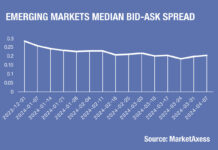By Carmine Calamello, Head of Brokerage & Execution, Market Hub, Intesa Sanpaolo, IMI CIB Division.
After a decade of expansionary monetary policy and interest rates close to zero, the sudden rise in rates across the globe represented a drastic paradigm shift. This abrupt change is the consequence of another unforeseen economic variable: inflation. To contain inflationary numbers unseen since the 70s, most central banks of developed countries have undertaken a tight path of interest rate hikes. Despite strong squeezes in interest rate plans, economic and labour data both in the US and Europe showed resilience throughout the year. It is only in the final economic releases of 2022 that we are seeing a signal of slackening, and this has prompted central bankers to reassess rate policies in favour of more gradual and data-driven hikes in 2023.
The above monetary policy changes made fixed income markets a hot topic for much of the second half of 2022 and, as a Bloomberg’s mid-November MLIV Pulse Survey confirms, market participants consider high interest rates as the biggest risk to global financial markets stability in 2023. Global double-digit inflation figures, expectations of further price pressures and the rates policies have led to increased activity in fixed income securities and in turn on fixed income derivatives products. The larger movements are recorded at the short end of the curve, with contracts on the two- and five-year US Treasuries recording the heaviest increase in trading activity. Institutional clients have been very active in fixed income futures, used mostly for hedging against sharp rate hikes, which has prompted many traders to move quickly into the market. Alongside the increase in fixed income futures trading, however, it is also worth noting the growing and concurrent interest in inflation-linked ETFs, which have seen great success, particularly among retail players for hedging against rate risk and protecting invested capital.
The role of CCPs
The paradigm shift by central banks and the increase in operations has affected the behaviour of CCPs that have worked to adjust initial margin requirements to compensate for volatility risks. In fact, FIA global data showed that the spike was reached in Q1 of 2022 due mainly to the Russian military operations in Ukraine.
This increase certifies the focus by CCPs in responding promptly against changes affecting the ETD market as default risk increases. At Intesa Sanpaolo we have had to cope with an increased number of margin calls both towards CCPs and clients. Customers pay close attention to the margin implications of a new position and to its pre-funding. Many customers, mainly the less sophisticated ones, were asking for support in forecasting the impact on a new position on their overall portfolio. There has been a substantial rise in clearing limit breaches by our customers, mainly due to increased initial margin requirements by CCPs rather than to increased derivatives open positions. This triggered many internal processes to reassess client limits.
Across Europe, we witnessed the same trend, further exacerbated by regional political events. Noteworthy is the increase in trading recorded by the Euro-Schatz futures contract, which constitutes a year-to-date increase of more than 70 percent compared to 2021 (according to October’s FIA quarterly volumes data). In Italy, client trading has focused mainly on BTP futures and options, thanks to attractive yields, and for hedging purposes in the face of political uncertainty due to the recent elections. In October, uncertainty also drove the pressure on British Gilts due to the controversial fiscal policy by the Truss administration and the consequent cooling intervention in the market by the Bank of England.
Beyond Europe
Shifting our focus to Asia-Pacific Exchanges’ quarterly volumes, trading activity remains flat year-to-date overall, but it increased notably on the China Financial Futures Exchange (CFFEX). Options on all contracts were heavily traded, being among the most preferred tools to hedge volatility. Open interest on interest rate ETDs was down 16% globally, as of September, compared to the previous year, but the results are heterogeneous across instruments. In general, the same shift recorded in volumes from the long end to the short end of the curve is also evident from open interest data.
On the regulatory side, in recent years, several central banks, regulators and financial market authorities around the world have undertaken an extensive process of reforming and revising benchmark rates. In the United States, the ARRC (Alternative Reference Rates Committee) – the working group mandated by the FED to identify replacement indices to USD LIBOR – evaluated the suitability of the Secured Overnight Financing Rate (SOFR) as a preferred alternative to the final transition from LIBOR on June 30, 2023. Traded volumes on SOFR contracts have consequently grown exponentially in view also of the decommissioning of the Eurodollar contracts scheduled for next year by the CME. Overall, short-term interest rate contracts (STIRS) were up around 20% with respect to 2021, in terms of volume, while contracts on sovereign debt increased in activity by around 14%. For most instruments, open interest has instead decreased, indicating the focus of market participants on short-term and intraday activity. The reforms to global reference rates have given birth to a new variety of traded instruments. With some products now redundant, the global turnover of interest rate derivatives has dropped by some 20% since 2019 (according to the BIS Quarterly Review, December 2022 International banking and financial market developments survey).
Options and futures on the 3-month SONIA (Sterling Overnight Index Average) rate have more than doubled in volume with respect to previous year, and are among the 20 most traded STIRS contracts, according to FIA Q3 data. Euribor contracts are also heavily traded, and the 3-month future is the fourth top-traded instrument among short-term rates, with an increase of 60% in volume on a year-on-year basis.
Amid markets that are characterised by high degrees of uncertainty, trading in fixed income ETDs certainly requires special care. By considering the multipliers associated with these instruments, and their sensitivity to market movements, we may realise the risks associated with trading them, only partially reduced by reading and interpreting macro data as well as by the knowledge of the risk of the trading books and of the market liquidity conditions.
The hawkish policies of the central banks and the market expectation of a focus on fighting inflation has also complicated the rolling activity on fixed income ETDs as liquidity was mainly directional, making it effectively more complex to find competitive prices or trade significant sizes at screen. Interesting volumes for fixed income ETD activity come from block trades where traders operate in futures with the physical exchange. The liquidity offered by market makers favours this type of trading at the expense of book trading, which is less liquid on the European markets. Many investors also trade to change portfolio duration by moving to different maturities.
Data for this article was sourced from FIA Q3 ETD trends data.
The author would like to thank Lorenzo Bracchi and Daniele Valeri for their collaboration in writing this article.
This article was first published in our sister publication, Best Execution
©Markets Media Europe 2023

















